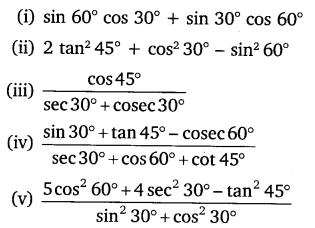NCERT Solutions for Class 10 Maths Chapter 8 Introduction to Trigonometry Ex 8.2 are part of NCERT Solutions for Class 10 Maths. Here we have given NCERT Solutions for Class 10 Maths Chapter 8 Introduction to Trigonometry Ex 8.2.
- Introduction to Trigonometry Class 10 Ex 8.1
- Introduction to Trigonometry Class 10 Ex 8.2
- Introduction to Trigonometry Class 10 Ex 8.3
- Introduction to Trigonometry Class 10 Ex 8.4
| Board | CBSE |
| Textbook | NCERT |
| Class | Class 10 |
| Subject | Maths |
| Chapter | Chapter 8 |
| Chapter Name | Introduction to Trigonometry |
| Exercise | Ex 8.2 |
| Number of Questions Solved | 4 |
| Category | NCERT Solutions |
NCERT Solutions for Class 10 Maths Chapter 8 Introduction to Trigonometry Ex 8.2
Ex 8.2 Class 10 Maths Question 1.
Evaluate the following:

Solution:



Ex 8.2 Class 10 Maths Question 2.
Choose the correct option and justify your choice:

Solution:


Ex 8.2 Class 10 Maths Question 3.
If tan (A + B) = √3 and tan (A – B) = \(\frac { 1 }{ \surd 3 }\); 0° < A + B ≤ 90°; A > B, find A and B.
Solution:
tan (A + B) = √3 = tan 60°
⇒ A + B = 60° …(i)
tan (A – B) = \(\frac { 1 }{ \surd 3 }\) = tan 30°
⇒ A – B = 30° …(ii)
On Adding equation (i) and (ii), we get
2A = 90° ⇒ A = 45°
From (i), we get:
45° + B = 60° ⇒ B = 15°
Thus, A = 45°, B = 15°
Ex 8.2 Class 10 Maths Question 4.
State whether the following statements are true or false. Justify your answer.
(i) sin (A + B) = sin A + sin B.
(ii) The value of sin θ increases as θ increases.
(iii) The value of cos θ increases as θ increases.
(iv) sin θ = cos θ for all values of θ.
(v) cot A is not defined for A = 0°.
Solution:
(i) False

(ii) True

(iii) False

(iv) False

(v) True

We hope the NCERT Solutions for Class 10 Maths Chapter 8 Introduction to Trigonometry Ex 8.2, help you. If you have any query regarding NCERT Solutions for Class 10 Maths Chapter 8 Introduction to Trigonometry Ex 8.2, drop a comment below and we will get back to you at the earliest.